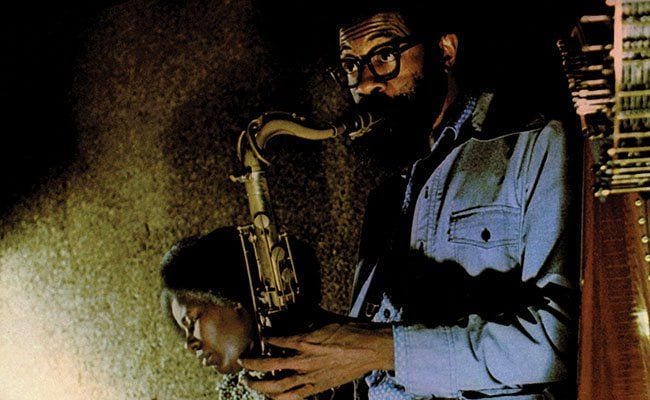
Following the death of her husband, legendary saxophonist John Coltrane, Alice Coltrane rarely worked as a sidewoman; instead, she put all of her creative focus into her own highly spiritual pursuits. Herself a member of the vanguard of new jazz creatives of the late 1960s, Coltrane’s approach to the music took the best of her late husband’s mesmeric qualities and put an even grander and more introspective spin on them through her compositions for larger ensembles. Through her use of the harp, in particular, Coltrane was able to create all manner of tones and textures that helped propel her music into new and different directions (while also maintaining a core spirituality that later manifested itself in music designed solely for meditative and religious purposes). Released under the Turiyasangitananda moniker–itself adopted from Sanskrit–they reflected her new, non-secular direction after moving to California and establishing the Vedantic Center and, later, served as the spiritual director of the Shanti Anantam Ashram.
Saxophonist Joe Henderson, while always a respected player, is rarely thought of as being a member of the more cosmic end of the avant-garde spectrum. Best known for his 1960s hard bop recordings for Blue Note, he, along with many other jazz musicians of the era, gradually expanded his sound, incorporating the burgeoning fusion school of thought into his own musical approach. This led to a handful of albums for Orrin Keepnews’ Milestone label on which he explored the gradually comingling worlds of jazz and funk while also incorporating electronic elements and a more stylistically eclectic approach. By the time he released The Elements in 1973, Henderson had fully immersed himself in a wide range of styles that saw his playing open up just that much more. Using the titular elements–“Fire”, “Air”, “Water”, and “Earth”–as a thematic jumping off point, Henderson, with the help of Coltrane on piano and harp, created this set of exploratory improvisational meditations.
Opening track “Fire” builds around a circular, muscular bass line courtesy of Charlie Haden that dances in and out of the vaguely Latin percussion groove established early on. When he enters, Henderson’s heavily reverbed horn adopts the titular mantle, conjuring images of flames leaping and dancing amongst the rock-steady rhythm section. It’s a far freer track than most anything else in Henderson’s catalog and shows him to be capable of just as forward an approach as his more celebrated peers. By branching out and losing himself within the instrumental interplay, Henderson adopts John Coltrane’s spiritual approach, if not necessarily his cascading “sheets of sound”. Pushed on by sympathetic players [Alice] Coltrane and Michael White on a searing, surging violin, Henderson manages to push himself into new and exciting territory throughout the whole of “Fire”s 11-minute run time. It’s an ecstatic opening salvo made all the more so by Coltrane’s coruscating harp’s arrival just past the half-way point. Here she methodically plucks out an Eastern-tinged melody interspersed by great swells across the whole of the instrument, lending her performance a hypnotically immersive quality. It’s a thrilling comingling of collective talent and sympathetic playing that leaves the listener wanting more from this particular line-up of players.
“Air” is an appropriately more spiritual jazz affair, with Henderson’s full-throated horn running the full range of his instrument while Haden and percussionist Kenneth Nash create a mood of constant forward momentum. It is here that he adopts a more Coltrane-via-Pharoah Sanders approach to his playing that treads lightly into avant-garde territory, borrowing heavily from his hard bop roots and pushing his horn to its physical limits (he always seems to stop just shy of Albert Ayler or Peter Brötzmann’s strident screaming). As the last of his sustained notes begin to fade, Coltrane’s waterfall-like piano comes crashing into the mix, gradually settling into a few descending chromatic runs down to the depths of the instruments lowest registers. Not nearly as successful as “Fire”, it nonetheless offers an interesting look into the group’s creative approach and improvisatory skill in a stylistically freer environment.
Most indicative of its time, “Water” opens with Coltrane’s droning Tambura, punctuated by Haden’s sparse yet forceful bass stabs, eventually leading into Henderson’s heavily affected psychedelic saxophone bouncing around the mix. It’s a jarring shift from the preceding tracks that, due to its varying level within the mix, is alternately fascinating and distracting, the notes chasing themselves across the track, fading out and gradually folding over onto themselves again. While the approach may be admirable, the execution is somewhat lacking. His brief tease of Gershwin’s “Summertime” is almost laughable in this context, an anachronistic reminder of where the music had been less than a decade prior. More than anything, “Water” is the most “out” track on The Elements.
Similarly, “Earth” features a decidedly Eastern bent which, with its slow, almost martial shuffle and Haden’s bass heavily accenting the “and” of four and the downbeat of one, is heavily reminiscent of Herbie Hancock’s “Vein Melter” (also released in 1973). In all, The Elements is neither indicative nor representative of the best work by either Henderson or Coltrane, instead offering an interesting tangent for both artists that neither would ever really return to. Rather, Coltrane went into firmly non-secular territory within the next year, and Henderson returned to a more R&B/funk-informed sound. An evolutionary dead end from a creative standpoint, The Elements nonetheless stands as an interesting, if not always successful, listen for fans of either artist and forward-thinking jazz in general.


![Call for Papers: All Things Reconsidered [MUSIC] May-August 2024](https://www.popmatters.com/wp-content/uploads/2024/04/all-things-reconsidered-call-music-may-2024-720x380.jpg)



